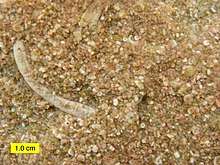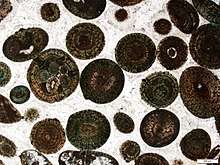Grainstone
Under the Dunham classification (Dunham, 1962)[1] system of limestones, a grainstone is defined as a grain-supported carbonate rock that contains less than 1% mud-grade material. This definition has recently been clarified as a carbonate-dominated rock that does not contain any carbonate mud and where less than 10% of the components are larger than 2 mm. The spaces between grains may be empty (pores) or filled by cement.


The identification of grainstone
The presence of any primary carbonate mud precludes a classification of grainstone. A study of the use of carbonate classification systems by Lokier and Al Junaibi (2016)[2] highlighted that the most common source of confusion in the classification of grainstone was to misidentify fine-grained internal micrite, generated by in-situ processes, as clay–silt grade sediment - thus resulting in the misidentification of grainstone as packstone. Failure to correctly determine the size and abundance of component grains >2 mm was also a source of error.
Dunham's original definition of grainstone stated that it must contain less than 1% mud to fine-silt grade (<20 μm) sediment. Embry & Klovan (1971)[3] and Wright (1992)[4] reduced the permitted amount of carbonate mud in a grainstone to zero. Given that grainstone facies are interpreted to have been deposited under high-energy conditions, it is sensible to preclude the presence of primary carbonate mud from this classification.
References
- Dunham, R.J. (1962) Classification of carbonate rocks according to depositional texture. In: Classification of Carbonate Rocks (Ed. W.E. Ham), Am. Assoc. Pet. Geol. Mem., 1, 108–121.
- Lokier, Stephen W.; Al Junaibi, Mariam (2016-12-01). "The petrographic description of carbonate facies: are we all speaking the same language?". Sedimentology. 63 (7): 1843–1885. doi:10.1111/sed.12293. ISSN 1365-3091.
- Embry, A.F. and Klovan, J.E. (1971) A Late Devonian reef tract on Northeastern Banks Island, NWT. Bull. Can. Pet. Geol., 19, 730–781.
- Wright, V.P. (1992) A revised classification of limestones. Sed. Geol., 76, 177–185.
